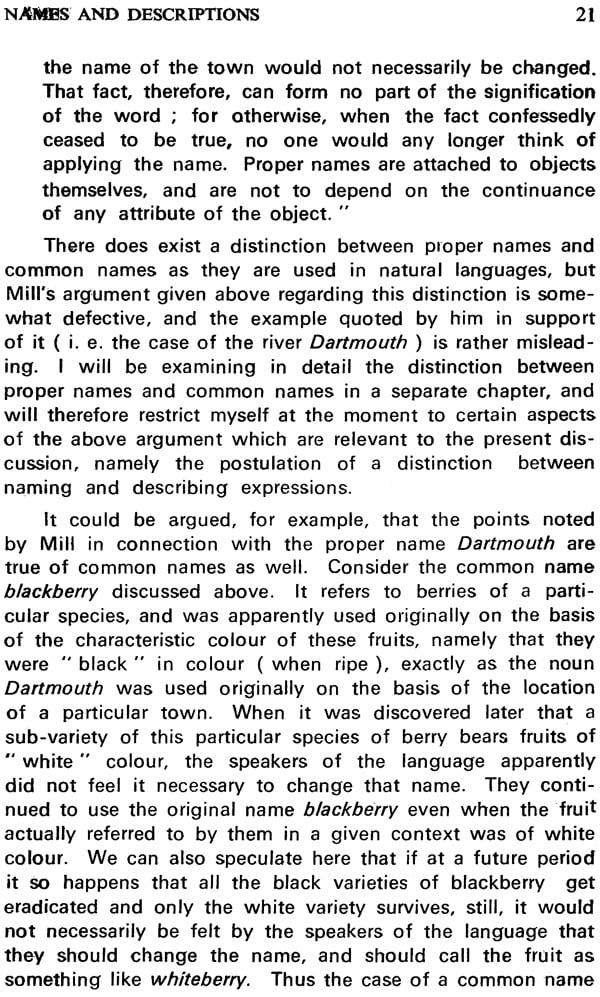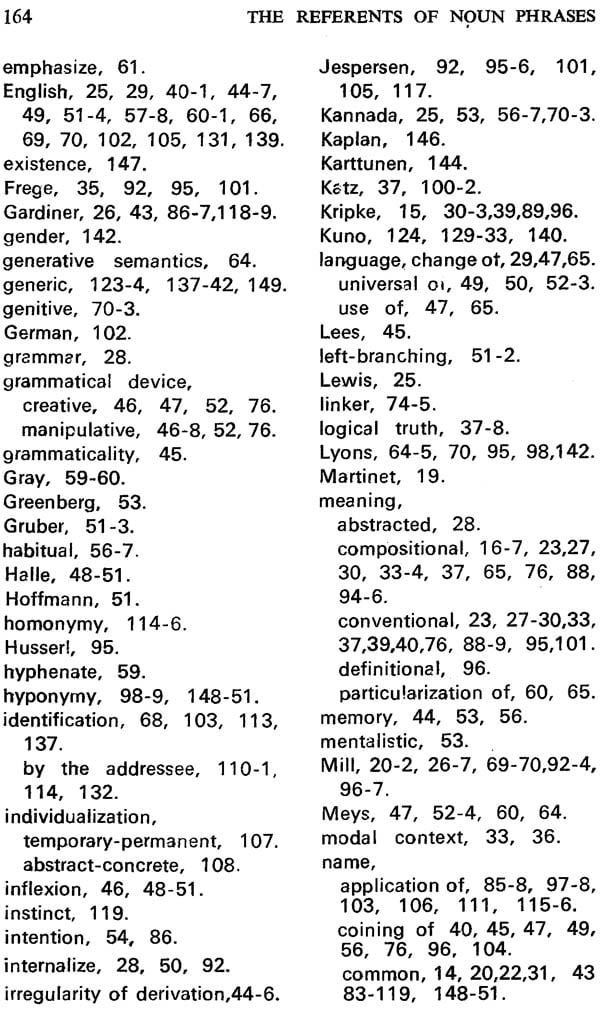
The Referents of Noun Phrases (An Old and Rare Book)
Book Specification
| Item Code: | NAM057 |
| Author: | D. N. S. Bhat |
| Publisher: | Deccan College Postgraduate and Research Institute |
| Language: | English |
| Edition: | 1979 |
| Pages: | 166 |
| Cover: | Paperback |
| Other Details | 8.5 inch x 5.5 inch |
| Weight | 210 gm |
Book Description
I have primarily tried to establish, in this monograph, a sharp and clear-cut distinction between two varieties of referring expressions, namely names and descriptions. I have given arguments in support of this distinction from the point of view of both linguistics as well as philosophy. I have pointed out here that the above distinction is restricted to a particular variety of linguistic expressions, namely the noun phrases.
On the basis of the distinction so established, I have tried to re-interpret two other distinctions that are generally conceded to be occurring among referring expressions, namely (i) the distinction between proper names and common names, and (ii) the distinction between the so-called referential and non-referential uses of nominal expressions. I have pointed out that the generic, nonspecific, predicative, and the attributive uses of noun phrases can all be brought together into a single variety of use on the basis of the fact that all of them represent a reference to the underlying characteristics of the noun phrases concerned, instead of a reference to a specific (or particular) entity that shows those characteristics.
Since all these three distinctions are of great interest to philosophers, logicians, and linguists, and since some very important facts concerning these distinctions have been newly uncovered in this monograph (especially about the distinction between names and descriptions), I am hopeful that the scholars working on these topics would find this monograph interesting. In my forthcoming monograph entitled Predication, I plan to examine the distinction between predication and reference (and also modification) on the one hand, and between the major varieties of predication on the other, so that some of the topics left untouched in this present monograph can be examined in detail.
The present monograph has resulted from a seminar course I gave for the M.A. Students of the University of Poona during the year 1978. I am indebted to my students and to my colleagues at the Deccan College who have helped me either directly or indirectly in developing these ideas. I am especially thankful to Dr. H. S. Biligiri who has carefully gone through this monograph in its manuscript form and has given many helpful suggestions.
| Preface | 9 | |
| Chapter One: Names and Descriptions | ||
| 1.1 | Introduction | 13 |
| 1.2 | Differences in the relationship with referents | 16 |
| 1.3 | Two different double articulations | 18 |
| 1.4 | Two Varieties of meaning | 20 |
| 1.5 | The nature of the conventional meaning | 23 |
| 1.6 | Distinguishing characteristics | 27 |
| 1.7 | Rigid and nonrigid designators | 30 |
| 1.8 | Referential opacity | 33 |
| 1.9 | Two varieties of analytic statements | 36 |
| 1.10 | Selecting a characteristic | 40 |
| 1.11 | Finiteness of names | 42 |
| 1.12 | Irregularity of denvation | 44 |
| 1.13 | Creative and manipulative devices | 46 |
| 1.14 | Distinguishing names from words | 48 |
| 1.15 | Relative order of constituents | 51 |
| 1.16 | Familiar and novel compounds | 53 |
| 1.17 | Compactness of names | 55 |
| 1.18 | Permanent and transient characteristics | 56 |
| 1.19 | Classificatory relevance | 57 |
| 1.20 | Names of natural and synthetic objects | 58 |
| 1.21 | Distinguishing compounding from naming | 59 |
| 1.22 | Derived nominals as names | 61 |
| 1.23 | Distinction among de-adjectivals | 64 |
| 1.24 | The question of a continuum | 65 |
| 1.25 | Restriction to nominals | 67 |
| 1.26 | Naming devices : genitive constructions of Kannada | 70 |
| 1.27 | Linker distinction in Tagalog | 74 |
| 1.28 | The case of the Sanskrit language | 75 |
| 1.29 | Summary | 77 |
| Chapter Two: Proper Names and Common Names | ||
| 2.1 | Introduction | 83 |
| 2.2 | Differences in application | 85 |
| 2.3 | Differences in recognition | 88 |
| 2.4 | Relevance of meaning | 92 |
| 2.5 | Relationship between names | 98 |
| 2.6 | Arguments based on analyticity | 100 |
| 2.7 | The criterion of translatability | 102 |
| 2.8 | The constraint of countability | 106 |
| 2.9 | The criterion of uniqueness | 108 |
| 2.10 | Definite and indefinite expressions | 111 |
| 2.11 | Proper names as homonymous terms | 114 |
| 2.12 | The question of a continuum | 116 |
| Chapter Three: Objects and Concepts | ||
| 3.1 | Introduction | 123 |
| 3.2 | Identifying characteristics as concepts | 127 |
| 3.3 | Predicative noun phrases | 129 |
| 3.4 | Attributive noun phrases | 133 |
| 3.5 | Generic noun phrases | 137 |
| 3.6 | Problems of pronominalization | 142 |
| 3.7 | Dichotomy of the distinction | 145 |
| 3.8 | Hyponymic substitution | 148 |
| 3.9 | Parsing f referring expressions | 151 |
| 3.10 | Conclusion | 155 |
| References | 159 | |
| Index | 163 |













